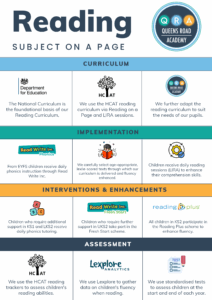Reading
Our Reading curriculum encourages a rounded yet structured approach to reading where phonics skills are applied to increase fluency, and therefore improve comprehension. As a Read Write Inc school, our reading books are levelled to match the progression in phonics in order to challenge children at an appropriate level to ensure accelerated learning.
Our aim is that all children pass their phonics screening check at the end of Year 1 and are comfortable in using phonics as their primary strategy for decoding words. This enables them to read fluently enough to use other strategies to develop a life-long love for reading.
Once children are ready to move away from discrete Phonics teaching, they access daily reading lessons. Our reading lessons use the LIRA approach to allow children to discuss several important aspects of reading: Literal meaning, Inferential meaning, Reader Response and Authorial Intent,
The texts for these sessions have been carefully selected to ensure they are age-appropriate, engaging, content relevant, rich in higher-level vocabulary, and at a reading level which is beyond age-related expectations.
Our sessions involve teacher modelling of reading with fluency, expression and emphasising punctuation. Through correct phrasing, children are also shown how reading has rhythm, and that understanding the rhythm helps the reader understand the author’s intended meaning. Intonation is also an important aspect of fluent reading as it shows that children are comprehending what they read. Through developing these reading disciplines, we aim for all children to fully comprehend the texts they study.
Assessment
Reading is assessed through various means. Teachers use the HCAT trackers for their year groups to allocate a level and next steps for each pupil to determine a holistic picture of a child’s reading ability. In order to assess fluency, we use the platform Lexplore, which gives a clear picture of various metrics including each child’s reading speed, frequency of regressions, and reading age.
In addition to this two formative assessment points are scheduled within the academic year. Cross moderation occurs in school every term during moderation challenge meetings.
Reading trackers are in place in every year group in order to build on skills progressively throughout school. Each reading tracker is segmented into the four key areas of comprehension; literal, inference, readers’ response and author’s intent. The HCAT trackers ensure teachers are carefully choosing age appropriate objectives and lessons are pitched correctly.

QRA Literacy Curriculum
At QRA we use the National Curriculum alongside HCAT documentation as the framework for the teaching of Literacy. This works in conjunction with our Early Reading and Spelling and Handwriting policies.
We endeavour to teach English with conviction, joy, skill and enthusiasm, and to feed the children with rich and meaningful literature experiences at every opportunity.
The Writing Curriculum
At QRA we use the HCAT writing curriculum which is based on the National Curriculum. The HCAT curriculum is split into writing composition, structure and purpose, grammar for writing, punctuation, spelling and handwriting as well as identifying discrete grammar skills which need to be taught to each year group. Year on a page documents have been tailored for each year group in order to ensure progressive coverage and high expectations for all.
Teaching writing centres around the use of Gather, Skills, Apply. This approach provides pupils with the opportunity to analyse elements of high quality texts, develop new or refine existing skills linked to the text type and apply this to writing. Pupils are explicitly taught the skills required to enable them to become successful and independent writers’. Throughout the ‘Gather’, ‘Skills’, ‘Apply’ phase, children have the opportunity to embed and practise their skills through the use of ‘Mini Applies’ in units of writing.
The Accelerated Learning Cycle, based on the work of Alastair Smith, is applied in all lessons. It stems from the idea of a supportive and challenging learning environment. The cycle has active engagement through multi-sensory learning, encourages the demonstration of understanding in a variety of ways and the consolidation of knowing.
Formative assessment is ongoing throughout each lesson. It judges progress and enables the teacher to make flexible adaptations to their planned teaching.Effective formative assessment, daily marking and feedback and adult interaction within lessons is firmly embedded into our approach to teaching and learning. All pupils are supported to develop, progress and move their learning forward through support, questioning and feedback. Pupils demonstrate the impact this has on improving their learning through editing and response.
Writing is assessed by teachers who use the HCAT trackers for their year groups to allocate a level and next steps for each pupil. We aim to produce at least 2 assessed pieces of writing per half term. Cross moderation occurs in school every term and pieces are gathered for a model portfolio. Moderation across trust and the LA support this process.